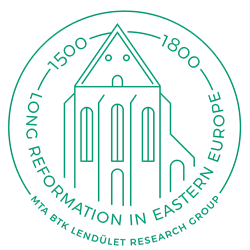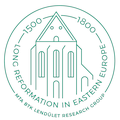Our understanding of Long Reformation takes as its starting point the concept of the multiple Reformations as it focusses on the confessional plurality of early modern Eastern Europe with a particular emphasis on Tripartite Hungary. From its very first signs of reception in the early 1520s till the Patent of Tolerance (1781) and its reinforcement by diet (1791), Reformation had been exercising a long lasting impact upon the culture and society of Hungary and Transylvania. Therefore, this project relies on the concept of Long Reformation not only as a tool of historical periodization, but as a possibility to revisit those cultural, social, theological or literary issues that had been shaping Reformation from 1500 to 1800 in Eastern Europe. It intends to reiterate the conviction that Reformation was not an abrupt and radical change, but an era of multifaceted transfers, translations, and complex transformations. Accordingly, our project is engaged in exploring three major thematic perspectives:
I. Long Reformation and Historical Writing
The concept of Long Reformation could prove to be a very useful methodologic tool that enables scholars to establish new approaches and research agendas when studying Reformation. The application of the concept and its timeframe (1500–1800) would allow revisiting some of the basic historiographic components of Reformation master narratives in general. For instance, it is of utmost significance to fathom how Reformation-related disparate and complex historical experiences had been forged into well-defined and coherent narratives integrated in national or European contexts. Similarly, Long Reformation as a critical tool assessing the historical writing of Reformation would provide a new perspective of inquiry regarding the making of Reformation as an era on both macro and micro-levels.
II. Social History and the Benefits of Long Reformation
From the perspective of social history, the significance of Long Reformation consists in changing the scale of analysis as it adds some 150 years to the period of Reformation. Thus certain social and cultural processes of transformation originating from Reformation, but unavoidably brought to a close by 1650s could be revisited and evaluated in the context of a longer period of time. For any attempt of grasping the transformations of late medieval society and culture to a Reformed society and culture imposes a certain usage and reliance upon time and timing as an interpretive precondition. It may turn out that this post-Reformation period (1650–1800) will reveal unknown and significant aspects of social and cultural changes previously discussed exclusively within the time limits of 1500–1650.
III. Literacy and Reading Culture during the Long Reformation
Long Reformation (1500–1800) implies unavoidably the reformation and transformation of medieval and early modern media not only as technologies but means to create texts. Accordingly, we are determined to investigate how a late medieval manuscript culture survived and developed alongside with print culture during a (very) long Reformation. A large array of themes will be covered from medieval and early modern reading-writing habits to the interconnections and exchanges between various media including the cohabitation and use of Latin and vernacular languages in both oral and written texts. In addition, this thematic repertoire shall also include the analysis of how a scribal and print publicity developed and coexisted in the context of early modern literacy, education, printing and publication. The main goal is to decipher the complex interactions between Long Reformation and the various genres of early modern Neo-Latin and vernacular texts in order to explore the processes of their production and circulation.


